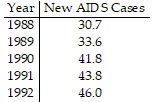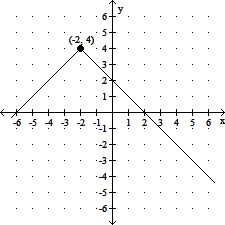Find the amount of ordinary interest you would pay for the following. Round to the nearest cent.A loan of $2000 at 11% made on February 7 and due May 31
A. $220.00
B. $68.44
C. $69.06
D. $2069.06
Answer: C
You might also like to view...
Provide an appropriate response.The amount of taxes withheld from your paycheck can be reduced by increasing the number of exemptions claimed on form W-2.
A. True B. False
Find the inverse of the function and state its domain and range .{(7, 2), (5, 3), (3, 4), (1, 5)}
A. {(2, 7), (3, 5), (4, 3), (5, 1)}; D = {2, 3, 4, 5 }; R = {7, 5, 3, 1}
B.  ; D = { 7, 5, 3, 1}, R =
; D = { 7, 5, 3, 1}, R = 
C. {(3, 2), (5, 3), (7, 3), (3, 4)}; D = {3, 5, 7}; R = {2, 3, 4}
D. {(3, 2), (2, 3), (7, 5), (3, 4)}; D = {(3, 2, 7}; R = {(2, 3 5, 4}
Solve the problem.The table shows the number of new AIDS cases (in thousands) in the U.S. in five consecutive years. Let x = 1 correspond to 1988 and let f(x) be the number of new AIDS cases (in thousands) in the U.S. in year x. Using the points
Let x = 1 correspond to 1988 and let f(x) be the number of new AIDS cases (in thousands) in the U.S. in year x. Using the points  and
and  the following linear function is obtained to model the data:
the following linear function is obtained to model the data:  Compare the number of new AIDS
Compare the number of new AIDS
cases given by the model in 1990 with the actual number of new AIDS cases that year. How accurate is the model? What will be an ideal response?
Find the domain and range of the function graphed.
A. domain: (-?, -2) ? (-2, ?); range: (-?, 4) ? (4, ?) B. domain: (-?, ?); range: (-?, ?) C. domain: (-?, -2]; range: (-?, 4] D. domain: (-?, ?); range: (-?, 4]